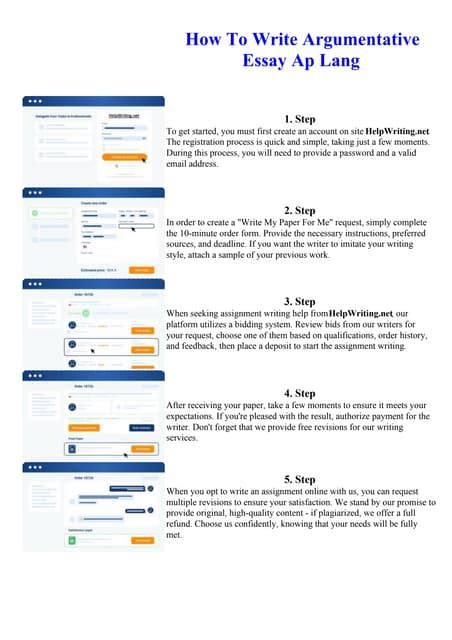Ace your Advanced Placement Language and Composition (AP Lang) argument essay with this foolproof guide. From understanding the prompt to structuring your argument, we’ve got you covered.

What is an AP Lang Argument Essay?
An AP Lang argument essay is a type of essay that requires you to develop a clear stance on a given issue and support it with evidence and reasoning. The prompt will typically provide you with a topic and a specific perspective to take.
Understanding the Prompt
The first step to writing a successful argument essay is to carefully analyze the prompt. Pay attention to the following:
- Topic: What is the main issue or claim being debated?
- Perspective: What is the specific stance you are expected to take?
- Complexity: How many sides to the issue are presented? Are there any nuances or counterarguments to consider?
Structuring Your Argument
The typical structure of an AP Lang argument essay is as follows:
Introduction:
– Hook: Start with a relevant quotation, anecdote, or statistic to grab the reader’s attention.
– Background: Provide context and define any necessary terms.
– Thesis statement: Clearly state your argument and the main points you will support it with.
Body Paragraphs:
– For each main point, provide evidence from multiple sources.
– Explain how the evidence supports your argument.
– Address potential counterarguments and provide evidence to refute them.
Conclusion:
– Restate your thesis statement.
– Summarize your main points.
– Provide a final thought or call to action.
Developing Strong Arguments
To create persuasive arguments, focus on the following strategies:
- Use credible sources: Cite reputable sources such as academic journals, government reports, and news articles.
- Provide specific examples: Support your claims with concrete evidence and illustrations.
- Acknowledge opposing viewpoints: Address and refute counterarguments with evidence.
- Use persuasive language: Employ strong verbs, vivid imagery, and logical reasoning.
Common Mistakes to Avoid
- Ignoring the prompt: Ensure your argument directly addresses the topic and perspective presented in the prompt.
- Lack of evidence: Support your claims with ample evidence from multiple sources.
- Weak reasoning: Avoid making unsupported generalizations or relying solely on personal opinions.
- Unclear structure: Maintain a logical flow of ideas throughout the essay.
- Grammatical errors: Proofread carefully for any grammatical or mechanical errors.
Step-by-Step Approach
1. Analyze the Prompt and Develop a Thesis
Read the prompt carefully and identify the main issue and perspective. Formulate a specific and defensible thesis statement.
2. Gather and Organize Evidence
Research reputable sources and collect evidence to support your main points. Categorize the evidence and plan the structure of your body paragraphs.
3. Write the Introduction
Write a compelling hook, provide context, and state your thesis statement clearly.
4. Develop Body Paragraphs
For each body paragraph, provide evidence, explain its relevance, and address potential counterarguments.
5. Write the Conclusion
Restate your thesis, summarize your main points, and provide a final thought.
6. Proofread and Edit
Check your essay for grammatical errors, clarity, and logical flow.
Effective Strategies
- Employ the “So What?” Technique: For each piece of evidence, explain why it is important and how it contributes to your argument.
- Use Transitions: Connect your ideas smoothly with transitions such as “Moreover,” “In addition,” and “On the other hand.”
- Consider Multiple Perspectives: Acknowledge and address different perspectives on the issue to demonstrate a balanced and comprehensive argument.
- Use Active Voice: Use strong and concise verbs to keep your writing engaging.
- Seek Feedback: Ask your teacher, classmates, or a writing tutor to review your essay and provide feedback.
Additional Resources
- AP Lang Argument Essay: A Step-by-Step Guide
- How to Write a Strong AP Language Argument Essay
- Argument Essay Writing Guide for AP Language and Composition Students
Tables
| Section | Key Points |
|---|---|
| Introduction | Hook, Background, Thesis Statement |
| Body Paragraphs | Evidence, Explanation, Counterarguments |
| Conclusion | Thesis Restatement, Summary, Final Thought |
| Strategies | “So What?” Technique, Transitions, Multiple Perspectives |
| Common Mistakes | Tips for Avoidance |
|---|---|
| Ignoring the Prompt | Focus on the specific topic and perspective |
| Lack of Evidence | Gather credible evidence from multiple sources |
| Weak Reasoning | Support claims with logical arguments and evidence |
| Unclear Structure | Maintain a logical flow of ideas |
| Grammatical Errors | Proofread carefully for errors |
| Evidence Types | Examples |
|---|---|
| Studies and Statistics | Government reports, academic journals |
| Expert Opinions | Quotes from experts in the field |
| Personal Anecdotes | Relevant experiences that support your argument |
| Examples | Specific illustrations that demonstrate your point |
| Active Voice | Passive Voice |
|---|---|
| The student wrote the essay. | The essay was written by the student. |
| The teacher corrected the errors. | The errors were corrected by the teacher. |
